
Transitions Online_Around the Bloc-13 May
Highlights from our coverage region: asylum seeker abuse in Croatia; opening up in Uzbekistan; Telegram abandons blockchain; stunning fossils in Bulgaria; and a friendly reminder for Georgia.
More...We kindly inform you that, as long as the subject affiliation of our 300.000+ articles is in progress, you might get unsufficient or no results on your third level or second level search. In this case, please broaden your search criteria.

Highlights from our coverage region: asylum seeker abuse in Croatia; opening up in Uzbekistan; Telegram abandons blockchain; stunning fossils in Bulgaria; and a friendly reminder for Georgia.
More...
Since Poland started the transformation from a country of emigration to a country of immigration, the legal environment related to the employment of foreigners has been constantly changing. These changes seem to be of a bumpy nature, although they implement in a relatively consistent manner certain assumptions that can be called systemic. This article will analyse main directions of legal changes related to the employment of foreigners in Poland, specifying at the same time the objectives that the legislator intended to achieve when introducing them. This will make it possible to show the organisational priorities of labour market regulation and the values that the national legislator aims to protect. Such an analysis, in turn, will make it possible to assess legislative actions and (in the case of their approval) to indicate further necessary improvements made in the spirit of the existing ones or (in the case of their criticism) to set new directions of actions.
More...
The article is aimed at seeking an answer to the question about the place of Polish immigrant organizations centered around cultural activities, Polish artists residing abroad and the general immigrant community within the organizational field focused on the promotion of Polish culture abroad. To answer the question, the author analyses key documents underpinning cultural policy and policy towards diaspora, describes the structure of organizational field including various kind of organizations engaged in promotion of Polish culture abroad. The policy analysis covered the presentation of assumptions on the role the diaspora should play both – as an addressee and the “tool” of public policies. Findings on positioning of organizations representing Polish diaspora in organizational field stemming from the analysis of documents were confronted with the results of state programs analysis. The author focused on 15 state programs ran between 2017 and 2022 – their goals and beneficiaries. The study reveals that immigrant organizations and Polish artist residing abroad had limited access to structural support for their projects, despite policy makers’ positive evaluation of diaspora resources. Members of diaspora are positioned at the periphery of national branding organizational field. Therefore, the resources of numerous members of Polish diaspora – dispersed around the whole world – are still underestimated and unused.
More...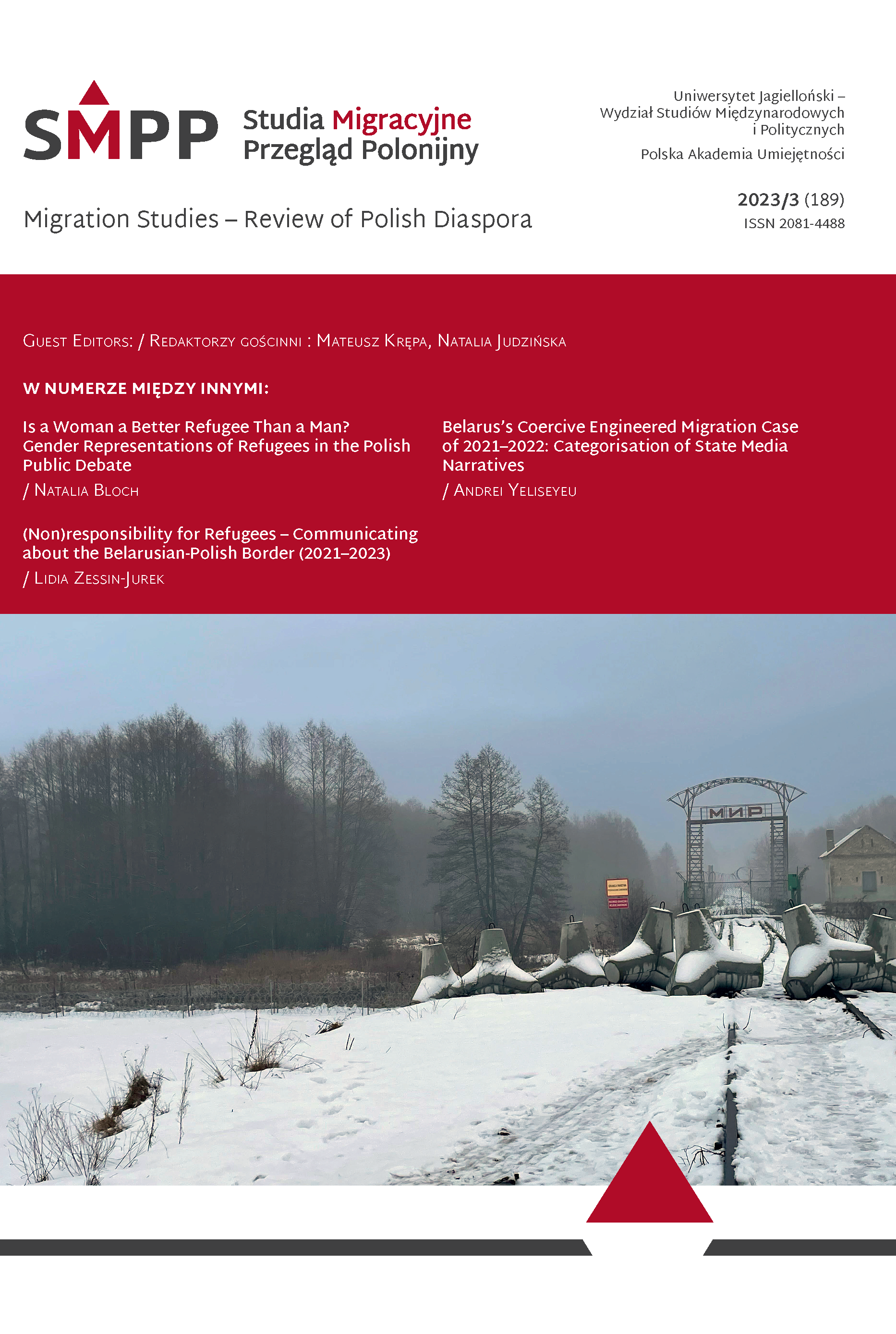

The pushed-back migrants are the main subjects of the humanitarian crisis on the Belarusian-Polish border; however their presence as public discourse producers are rather scarce. The aim of this research is to trace the narrative agency of these people and explore its link to their emancipation. Drawing on the postcolonial theory, we address the question of how the subaltern(ised) subjects produce their discourse. With the analysis of media content, literature, and artistic materials, we argue that the discourse production of pushed-back migrants in Poland is heavily limited, restricted, and often interrupted, however they manifest agency by manoeuvring victimisation and contesting the enemisation of themselves. Using these results, we conclude that the researcher’s role during this crisis should be a mix of translation and representation of what the pushed-back said and were forbidden to say.
More...
Within the framework of global mobility regimes, some bodies are encouraged to move while others are pushed back. Nation-states create control mechanisms to block those who are “undesirable”. Apart from political utility, the colour of the bodies is indicated by the critics as the main criterion of division. However, one more important dimension that intersects with race here is the gender of these bodies. A woman fits the figure of an ideal victim better due to the nationalist patterns of femininity: she is vulnerable, submissive, and deprived of agency. Contrary to a man: his duty in the context of war is to remain in his homeland and fight for it. A man who does not do that, seeking asylum in Europe, is morally doubtful: he is a migrant posing a threat to “our” prosperity and security. This is how people crossing the Polish-Belarusian border are presented to public opinion and contrasted with female Ukrainian refugees. The article offers a critical analysis of gender representations of refugees in the Polish public debate through the prism of postcolonial theory, demonstrating that gendered and racialised colonial discourses underpin rationalisations about who has and who does not have a right to be a refugee.
More...
This study deploys a narrative analysis of stories on the topic of the so-called migration crisis on the EU-Belarus border published on the website of the key Belarusian publishing house Belarus Segodnya between the 1st of June 2021 and the 31st of March 2022. The key eleven narratives were deconstructed through a close engagement with and interpretation of over 1,500 topical publications. The ongoing humanitarian crisis at the EU-Belarus border which peaked in late 2021 followed from the Belarusian regime’s attempt to attain foreign policy goals, foremost the suspension of EU sanctions. The study applies the concept of coercive engineered migration proposed by Kelly Greenhill and finds that the content of most identified narratives fits Greenhill’s predictions that coercing actors focus on manipulating the ability and willingness of targeted states to accept groups of migrants and that challengers tend to impose hypocrisy costs on targets to increase coercive power. The analysis suggests that some of the major state media narratives fit into two groups of coercing strategies proposed by Greenhill while others can be accommodated in the category related to hypocrisy costs. These “blame shifting” narratives cast full responsibility for the origin and persistence of the migrant crisis on the targeted actors. An additional “triggering catastrophe” category is proposed which includes narratives which project cataclysms for the targeted actors and high cost of not hosting migrants for them.
More...
Given that two dramatically different refugee regimens have developed along Poland’s eastern border, this essay explores the social conditions and discourses that facilitate such a radically different treatment of people. The Polish state’s violation of human rights on the Belarusian section of the border and the celebration of these rights on its Ukrainian section have become part of media spectacles. This text analyses both the technical and content-related issues of communication about migrants and refugees from the Global South. It includes typologies of attributional biases in the media towards people on the move, discusses their functions and the ways towards a normalisation of violence. The final section historicises the current negative responses to refugees and sets them in the wider context of the uneasy obligations imposed on the “West” by its professed values. In doing so, this essay touches upon questions not only of a sense of social responsibility, but also of actual responsibility for the people who have died in Polish forests and rivers.
More...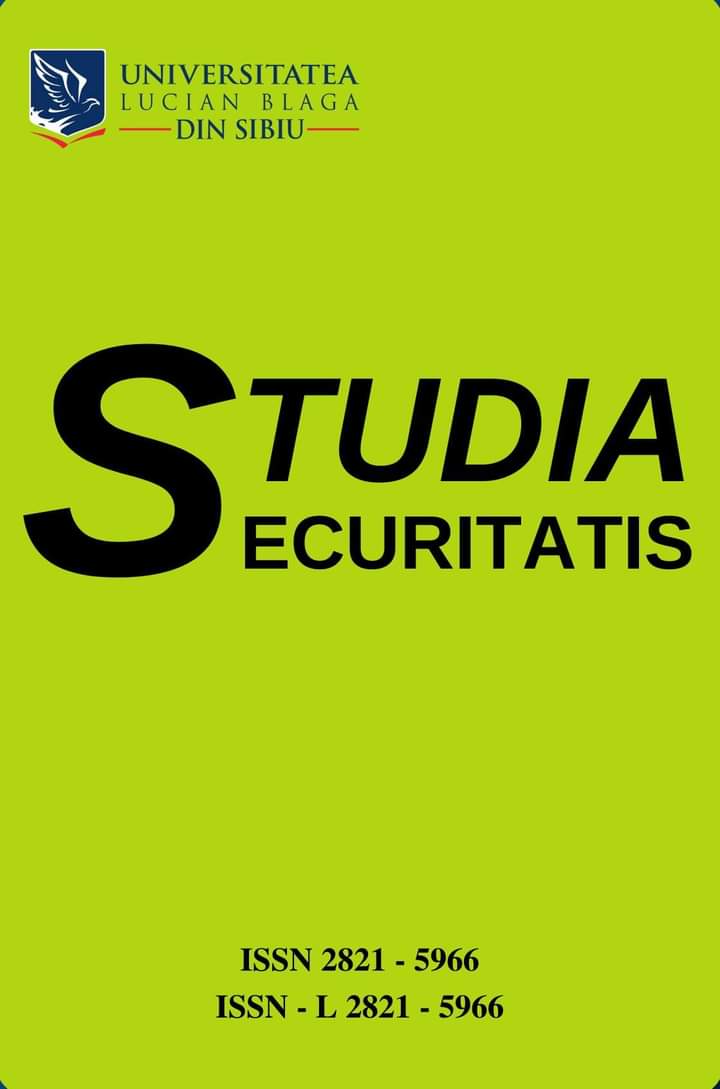
The fundamental necessity of every society is the security of her citizens against internal and external aggression. A secured society promotes development and attracts investors thereby promoting socio -economic well-being of the citizen and building responsible and responsive citizens. The high rate of insecurity has denied Nigeria government and citizens of peaceful atmosphere and socio-economic prosperity is at the low ebb. The intermittent conflicts such as ethno religious, communal, insurgency, farmers – herdsmen conflict has weakened Nigeria security architecture. The emergence of ethnic militias and non-state actors contributed immensely to the insecurity in Nigeria.The complex security situation in Nigeria ranging from insurgency, ethno religious, oil theft, farmers- herdsmen, kidnapping, drug, and human trafficking coupled with the porous borders and associated criminal activities among others were critically examined and posed that socio-economic development and livelihood of Nigeria are at risk, except proactive measure designing to incorporate bottom- top approach, Nigeria will soon slide into failed or collapsed state. This paper, therefore, recommends promotion of socio–economic, collaborative intelligence approach as well as empowerment will contribute in no measure to degrade insecurity and ensure peaceful co-existence.
More...
Migration and security are two complex and interconnected concepts, which have become increasingly relevant and discussed in the context of the continuous development of the globalization phenomenon and at the same time, in the current geopolitical context on the international stage, in which the political situation in certain states becomes critical and conflictual. The phenomenon of international migration from the non-EU area has materialized more and more frequently in recent years, in terms of waves of refugees and illegal migrants arriving in the European Union, reaching the highest figures recorded in 2015. In this respect, the issue of migration, refugees and asylum seekers has become in the last decade a topic included on the European security agenda of the European Union and at the same time a main topic of discourses by European leaders and research dealing with the issue of "securitization of migration". Starting from the hypothesis according to which the migration phenomenon known as the "refugee crisis of 2015", by the way it unfolded and by the management proposed by the institutions of the European Union, produced a division at discursive level among European leaders, the purpose of this thesis is to demonstrate that migration from the European Union has been catalogued and perceived at a discursive level, in 2019-2021 a threat to European security.
More...
This paper explores the political landscape of war-torn Ukraine, focusing on the country’s core domestic problems. The war in Ukraine has led to a significant deterioration of Ukraine’s political landscape. While victory on the battlefield is Ukraine’s utmost priority, escalating internal problems pose additional challenges. With Ukraine having obtained EU candidate status, these problems have moved to a new level on the EU’s membership agenda. The most urgent of these is endemic corruption, which has gained fresh momentum during the war and has put foreign aid at risk. As the costs of the war grow, international pressure on the Ukrainian authorities to show better results increases. Accountability and transparency should become the guiding principles of the reconstruction and recovery processes to maintain Western support and ensure effective postwar reconstruction.
More...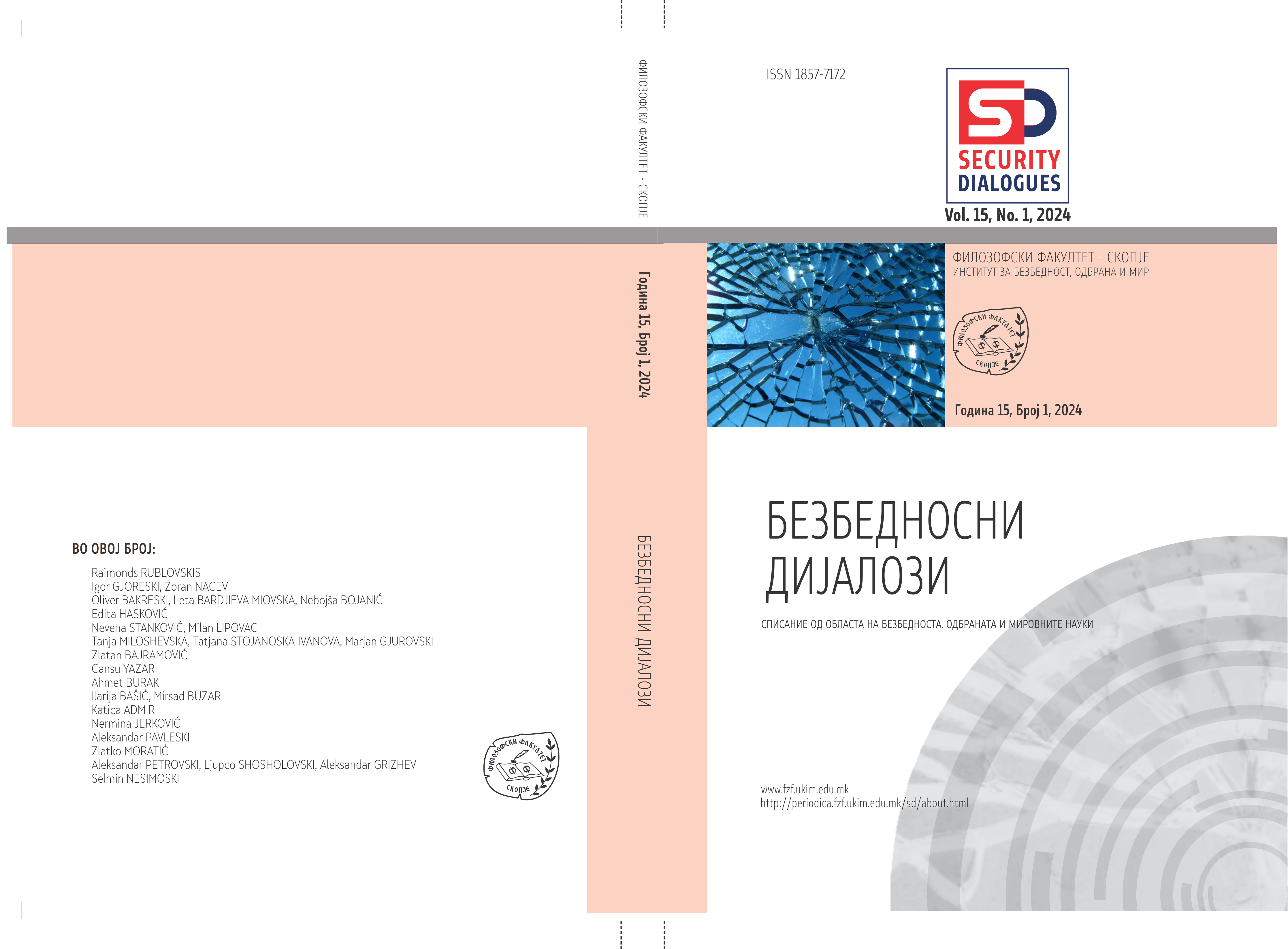
This paper seeks to improve understanding of the risks and types of sexualand gender-based violence faced by migrants, as well as ways of providing protection and assistance within the mixed migration context in Bosnia and Herzegovina. The Center for Disease Control and Prevention states that over half of women and almost 1 in 3 men worldwide have experienced sexual violence involving physical contact during their life times. Even though the prevalence of sexual violence is high, its exact scope is unknown due to its vast underreporting. Sexual violence against people on the move is widespread. Regardless of age and gender, this population is highly vulnerable to becoming victims of sexual and gender-based violence during their journey toward the desired destination. How the proper activities aimed to prevent and treat the consequences of sexual and gender-based violence in the humanitarian context are set up in Bosnia and Herzegovina and what kind of services are provided to victims will be discussed within the paper. How important the role of humanitarian workers is, their understanding of sexual and gender-based violence, and their readiness to provide adequate care, recognize the types of sexual violence, and use all the benefits of the existing referral pathway properly will also be broadly explored.
More...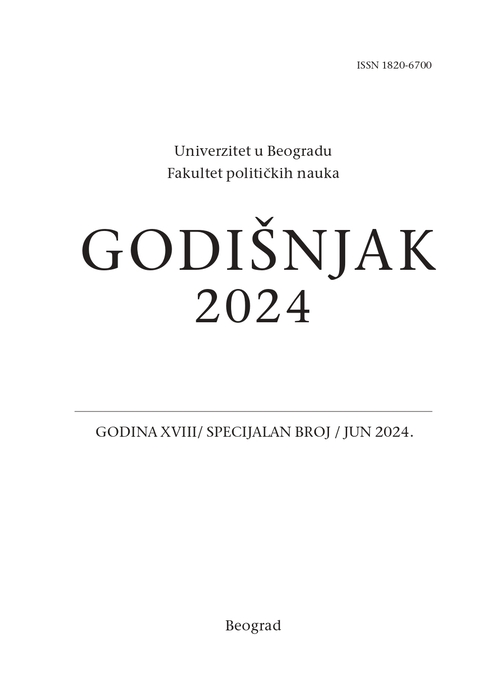
The refugee crisis, which began with the war conflicts between the Russian Federation and Ukraine in February 2022, is one of a series of humanitarian crises that have affected the area of Europe in the last few years, with the consequence of causing social insecurity for many people across Europe. The member states of the European Union had to adapt to the new circumstances in a short period of time. The key research question of the paper is: what the specifics of the current refugee crisis for national social policies are and how did key destination countries respond to the crisis, with a special focus on labor market policy measures and outcomes. The paper analyses the integration programs of refugees from Ukraine, using the institutional approach, content analysis and comparative method. The management of the current crisis, under the auspices of the EU, has been significantly improved compared to the migration crisis management model from 2015. On the other hand, in the observed countries of destination, the biggest challenges were recorded in adapting the active labour market policies to the specifics of the last crisis, which should enable a longer-term social and economic integration of refugees.
More...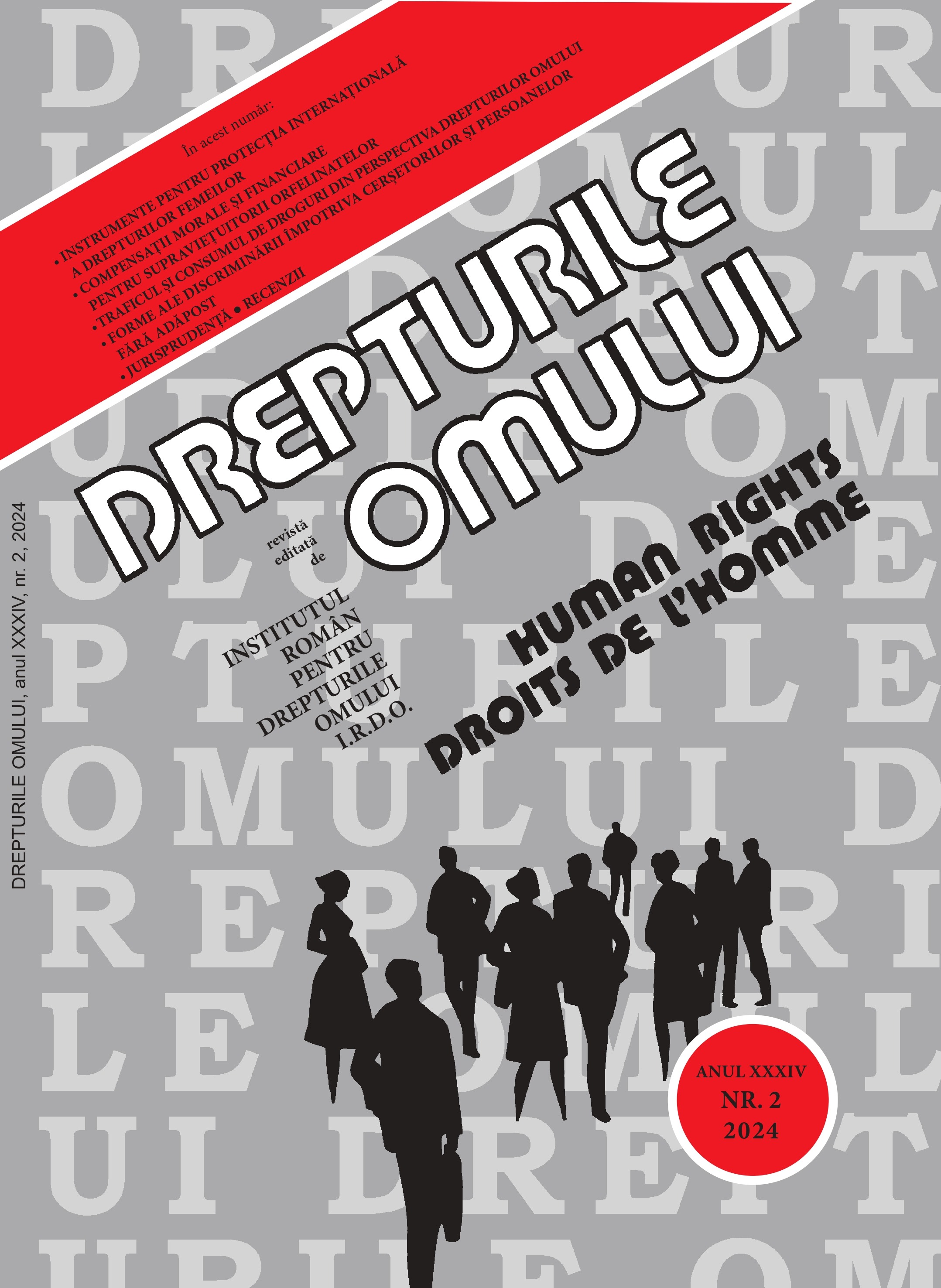
Racism does not always manifest in the form of overt acts such as racial violence or hate crimes, which are visible, explicit, and easily identifiable. Rather, it is deeply embedded within the very fabric of society, operating through the structures of social, economic, and political institutions. This systemic form of racism results in unequal treatment and perpetuates ongoing disadvantages. The current report examines these widespread systems of inequality, which affect both individuals and particular communities at a structural and institutional level, specifically focusing on structural and institutional racism. Its purpose is to analyze the situation in eight EU member states (Czechia, Germany, Greece, Latvia, the Netherlands, Romania, Spain, and Sweden), to present an overview of the current state of affairs, and to provide a preliminary set of recommendations for both national and European authorities.
More...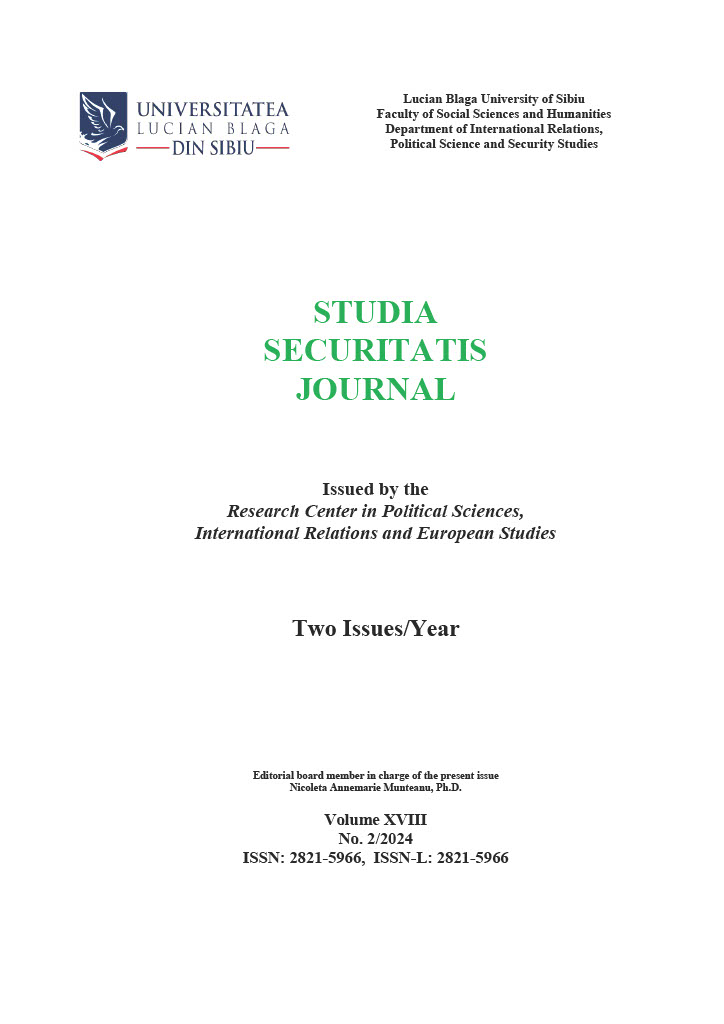
The outbreak of full-scale war in Ukraine resulted in the largest population migration after the Second World War. Poland, as a border country, had to respond to the challenges of the sudden influx of war refugees (around 3 million) within 2 months of the start of the war. It also must respond now, more than two and a half years after the outbreak of war, when there are more than 1 million Ukrainians on Polish territory. The article presents the legal solutions introduced in response to the war migration. They concern the following areas: simplification related to legalisation of stay, facilitation of taking up employment and access to social benefits. As there are many children among the migrants, the last area concerns access to school education for Ukrainian children.
More...
In the context of increasing migration and refugee flows, the integration of new advanced technologies into border security and their implications for human security requires considerable adjustment. AI-driven surveillance, biometric identification, and automated controls at the border have become part of strategic security measures. While these technologies seek to create “smart borders” for effective functionality, major concerns are raised for data privacy and civil liberties, and the potential for discriminatory practices against vulnerable populations. The analysis describes ethical and humanitarian dilemmas created by the technologization of border management concerning issues for access to international protection by asylum seekers under the 1951 Refugee Convention. It does so by drawing on comparative case studies from the member states of the European Union, illustrating how different geopolitical contexts shape the deployment and regulation of those technologies. This research calls for a balanced policy approach that incorporates the notion of border security with the principles of international human rights law, thereby advancing a framework that protects the dignity and rights of all individuals.
More...
Migration has become a pivotal global phenomenon, raising crucial concerns about human security and crime prevention. This article delves into the interconnectedness between human security and migration, emphasizing the importance of institutional cooperation in addressing these challenges. Human security, encompassing economic, social, political, and cultural dimensions, is a multi-faceted concept that becomes particularly relevant when discussing migration. Migrants often face vulnerabilities, such as exploitation, discrimination, and socio-economic instability, which can lead to heightened risks for both individuals and communities.A significant focus of the article is the role of institutional collaboration in enhancing human security and preventing crimes related to migration, such as human trafficking, smuggling, and organized crime. Government agencies, international organizations, and NGOs play a key role in managing these issues, ensuring that migration is handled in a way that minimizes risks while promoting safety and inclusion. Successful case studies of interagency collaboration highlight how information sharing, joint training, and coordinated intervention strategies have led to positive outcomes in safeguarding both migrants and local populations.However, the article also explores the challenges that hinder effective collaboration, such as resource constraints, conflicting interests, and coordination gaps. Restrictive migration policies can exacerbate these issues, making it more difficult for institutions to work together efficiently and placing additional strain on human security.To overcome these challenges, the article suggests strengthening institutional frameworks, fostering cross-agency communication platforms, and promoting education to raise awareness and reduce biases against migrants. A shift toward migration policies that prioritize human security is also recommended, aiming to protect both national interests and migrant rights, creating a safer, more inclusive environment for all involved
More...
The mass emigration of 1991, the mass migration following the 1997 financial crisis, and the migrant surge during the Kosovo conflict in 1999 were the three main waves of Albanian migration to Italy. In addition to the initial surprise and lack of preparation on the side of the Italian people and governmental bodies, each of these waves was marked by incredibly challenging initial conditions. The Albanian immigrants’ integration process is today viewed as a largely successful narrative. What were the primary causes of the comparatively quick integration following such a dramatic beginning? Young age, medium educational attainment, big family size, lack of religious affiliation, and comparatively high level of familiarity with Italian language and popular culture are characteristics that identify Albanian immigrants. Also, the Italian government has taken significant steps towards integration, including legalizing undocumented immigrants and reaching agreements with their Albanian counterparts on the repatriation of Albanian individuals convicted of crimes. The primary issues and patterns that have surfaced during three decades of migrant flows are examined in this article. Particularly, it emphasizes integration into the workforce and culture, and how the media depicts and influences the relationship between migrants and the host country. Integration data have been examined in the context of Italian political and social dynamics. A few integration factors have also been studied, with a focus on the demographics of migrants and refugees during the main migratory waves. It may be possible to determine the least stressful and most successful cohabitation techniques throughout Europe's difficult and ongoing migrant waves by looking at these integrating components.
More...
The paper examines the interaction between bombing urban areas in contemporary warfare and the competing discourses on human rights, considering the perspectives of international institutions, state actors, civil society, and victims. It explores not only the international legal frameworks governing armed conflict and human rights when urban space become the target of military operations, but also the ethical and humanitarian implications of bombardments in tightly inhabited areas, drawing attention to civilian victims, infrastructure destruction, displacement, and long-term collective trauma. It further investigates the need for a change to protect civilians more effectively in urban settings. Eager to contribute to ongoing legal, ethical, and policy debates on contemporary warfare and human rights, the paper leverages different methods to address the issue. It uses case study analysis, looking at recent examples of urban bombing campaigns to understand their impact on human rights. It also uses a multi-perspectival analysis of the competing discourse on the issue examining legal documents, government statements or reports by human rights organizations. Finally, the paper uses normative argumentation to advance a more cosmopolitan view on human rights on the international agenda.
More...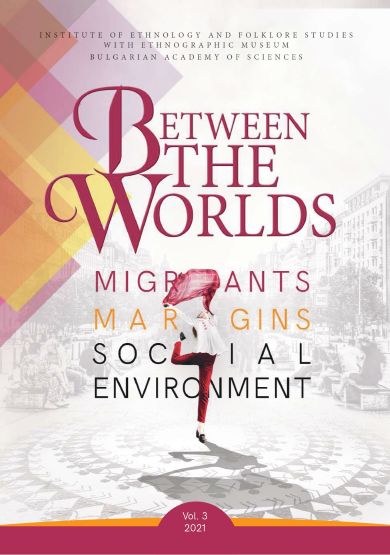
Based upon ethnographic fieldwork conducted amongst families of Bulgarian Roma returnees and refugees from the Middle East in Bulgaria, this paper discusses the problems of adaptation, which children face in elementary and secondary schools. Using a dialogical approach as the main strategy of fieldwork, I interviewed Roma returnee parents and children from different settlements, on the one hand, directors, homeroom teachers, and school staff, on the other, as well as experts in education. I conducted research amongst refugee families from Afghanistan, Syria, Iraq, and Iran in the southern town of Harmanli, where a refugee camp was set up in 2013. I am specifically interested in the children’s enrollment for the school years 2017 – 2018 and 2018 – 2019 when, for the first time, refugee pupils are enrolled in larger numbers in public schools, as a result of the introduction of Ordinance No. 3 of 2017. On the basis of the fieldwork material and reviewed documents, I state that the approaches to returnee and refugee students can be called ‘mainstream’ and ‘specific’ approaches. Under the mainstream approach, the pupils are categorised as ‘children of Bulgarian citizens living abroad’ and none of them are specifically labeled as ‘Roma’. The attitude towards them is similar to that of children of other Bulgarian return migrants. A special (targeting) approach is adopted for refugee children, who are included in the same group of ‘vulnerable’ students along with Roma pupils, assuming that both do not have a good command of the Bulgarian language and are at risk for unsuccessful adaptation at school.
More...